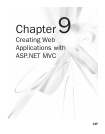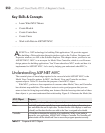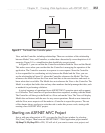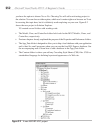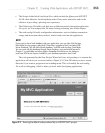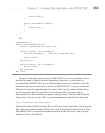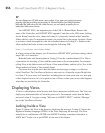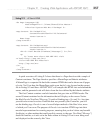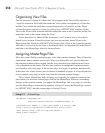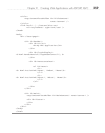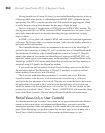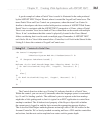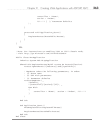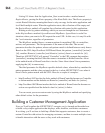
Chapter 9: Creating Web Applications with ASP.NET MVC 257
Listing 9-2 A View’s HTML
<%@ Page Language="C#"
MasterPageFile="~/Views/Shared/Site.Master"
Inherits="System.Web.Mvc.ViewPage" %>
<asp:Content ID="indexTitle"
ContentPlaceHolderID="TitleContent"
runat="server">
Home Page
</asp:Content>
<asp:Content ID="indexContent"
ContentPlaceHolderID="MainContent"
runat="server">
<h2><%= Html.Encode(ViewData["Message"]) %></h2>
<p>
To learn more about ASP.NET MVC visit
<a href="http://asp.net/mvc"
title="ASP.NET MVC Website">
http://asp.net/mvc
</a>.
</p>
</asp:Content>
A quick overview of Listing 9-2 shows that there is a Page directive with a couple of
Content containers. The Page directive specifies a MasterPage and Inherits attributes.
A MasterPage is a separate file that holds common HTML that can be shown on all pages
of a site. You’ll see how the MasterPage works soon, but let’s stay focused on the current
file in Listing 9-2 until then. ASP.NET MVC will compile this HTML into code behind the
scenes, and the generated code will derive from the class defined by the Inherits attribute.
The first Content container can hold metadata that goes into an HTML header
. The
second Content container has the information that will display on the screen. Notice
the Html.Encode(ViewData["Message"]) inside of binding tags <%= and %>. Any time
you add code or need to access ViewData that was passed by the Controller, you will
use the binding tags. Encode is one of several helper methods of the Html class, more
of which you’ll see soon. The purpose of Encode is to translate HTML tags into their
encoded representations for security purposes, ensuring that you don’t show any harmful
JavaScript, or other markup that could possibly execute, to the user. ViewData["Message"]
should be familiar, as it was set in the Index action in Listing 9-2 but is now being read
and displayed on the screen by this View.



